This was published 8 years ago
Trans-Mongolian train trip: A rail journey like no other
By Ben Groundwater
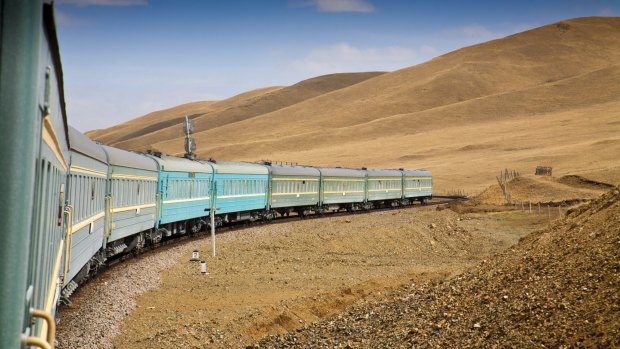
Trans Mongoian railway: Approaching Ulan Baator.Credit: Jane Sweeney
The wind whistles across the Mongolian steppe, stinging cold noses, making prayer flags rustle and snap, as we prepare to take part in an ancient ritual. It doesn't matter that we're non-believers in this strange land, far from home – we still scratch around in the dirt, searching for a few rocks of a decent size, ready to observe tradition, ready to commit them to the sacred stack. Before a journey like this, every little bit of luck counts.
And so we walk three times around this "ovoo", this cairn of stones and prayer flags, part Buddhist symbol and part Shamanic shrine, that sits high on a hill in central Mongolia. We have to walk an odd number of circles to ensure things work out well: happy, sad, happy; good, bad, good; lucky, unlucky, lucky. We have to walk clockwise. We have to toss a stone on the pile each time.
I shuffle around the cairn, throwing a rock after each lap, hearing the clink of stone on stone echo in the thin, clear air, adding in a small way to a mound that might have been there for centuries, thinking all the while about the journey that lies ahead: more than 6300 kilometres of overland travel, a 10-day adventure across two continents and five time zones, a colossal voyage the likes of which people save for and dream about their entire lives.
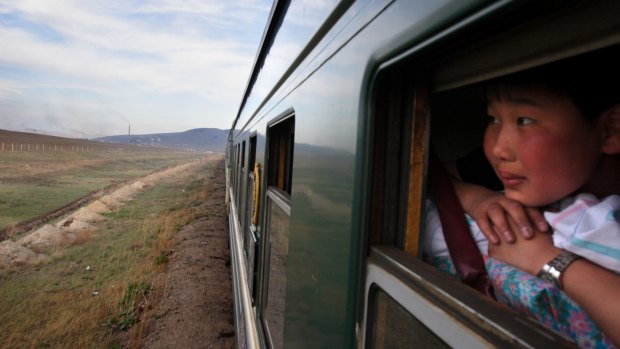
The Trans-Mongolian train leaves Ulaan Baator, Mongolia en route to Siberia, Russia.Credit: Alamy
The Trans-Mongolian railway. Make it a safe journey, I think. Clink. Make it a fascinating journey. Clink. Make it a journey I share with a group of friendly fellow travellers who aren't going to drive me nuts after 10 days being cooped up in a train with them. Clink.
The Trans-Mongolian: there's so much romance in those few words, such a thrill in repeating them to yourself. It's one of the world's grandest adventures, a classic train trip through parts of the globe that at times can feel completely undiscovered. It's a voyage through the Gobi Desert, along the high Mongolian steppe, around glittering Lake Baikal, through endless Siberia and on, gradually, slowly, inexorably, towards the might and power of Moscow. It's a variation of the famous Trans-Siberian, one that calls through even more diverse cities, and travels through more diverse lands.
Right now I'm in Mongolia, at a spot deep in the hills near Terelj National Park. This area is studded with huge rocky outcrops that mark an otherwise featureless land. My journey begins here, though there are many sharing this experience who boarded our train a few days ago in Beijing, in yet another world. They're still telling tails of forbidden cities and dumpling dinners, but their focus is slowly turning to what's ahead.
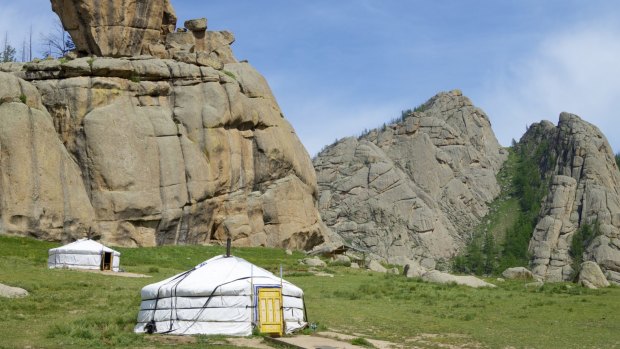
Yurts in field, Gorkhi-Terelj National Park, Mongolia.Credit: Pedro Salaverra
We're out on day excursion from Ulan Baator, the Mongolian capital that might have a few attractions of its own, but which pales in comparison to the riches of the surrounding countryside. Mongolia is known for the "steppe", this vast swathe of high-altitude wilderness dotted with the traditional white gers, or yurts, that the nomadic local farmers still live in.
We called into one of those gers earlier, gaining a window into local life (and cuisine). Later, we'll eat a larger lunch in the national park and then make the slow drive back to Ulan Baator, ready for the journey proper to begin.
This evening we're boarding the Czar's Gold, a private train that travels the length of the Trans-Mongolian railway. This is train travel of the classic kind, where the beds are wide and comfortable, the food is tasty, and the service impeccable.
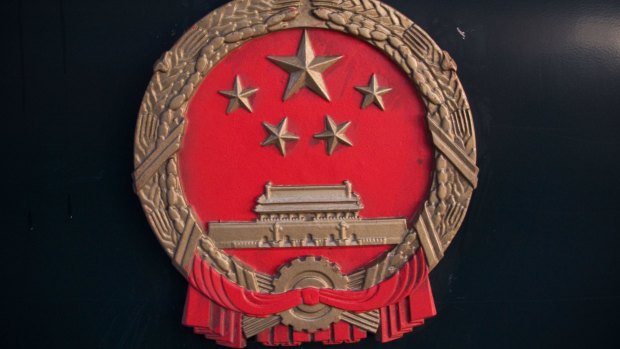
Detail from Trans-Mongolian train at Beijing train station.Credit: Alamy
While public trains that travel this route will plow on across the continent with barely a pause to change locomotives, the Czar's Gold keeps to a much more sedate itinerary, one that is more like that of a river cruise: the bulk of travel is done overnight, while excursions are organised each day to check out local cities and attractions and to stretch the legs.
I've done the Trans-Mongolian journey before, although I did it aboard one of those locals trains where I had very little idea of where I was, what was happening, of even which time zone I was in. This will be different. Things will make sense. On the Czar's Gold I have a dedicated English-speaking guide, Svetlana, as well as a tour director, Hans, who speaks eight languages, and local guides in each city. What was once a murky, confusing land will slowly begin to reveal itself on this long and beautiful journey that begins with just a few short steps around a cairn of stones.
RAILS RUN
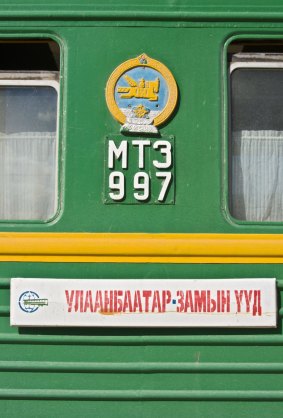
Green railway carriage and destination board for Ulan Baator - Zamyn Uud train.Credit: Tim Makins
Click-clack, click-clack, click-clack. There's a rhythm to train travel that very quickly lulls you into relaxation. It's not just the rattle of wheels on rails – it's the daily routine, the lazy breakfasts down in the dining car, the daylight hours spent reading or talking or staring out of the window, the huge dinners and the long evenings getting to know people from around the world.
Nineteen nationalities are represented on this journey of the Czar's Gold, 156 people from countries as disparate as Brazil, Norway, India, the US, Israel, and France. For many this is the realisation of a lifelong dream; these are genuine train tragics who've always wanted to experience the longest and the most remote.
And right now, we're remote. As the wilderness of Mongolia dissolves into the twilight, our train rattles ever north towards the Russian border. Even in the daylight there wouldn't be many features to see out there: just vast plains and the occasional herd of cattle.
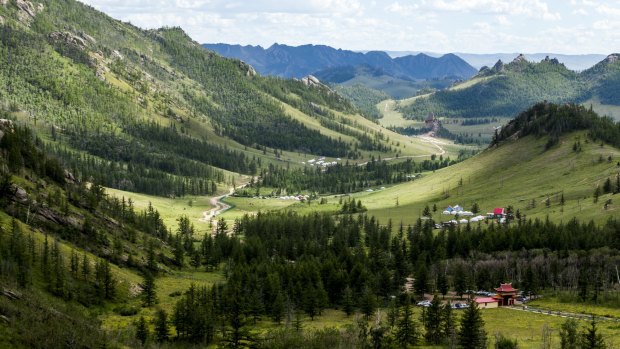
Gorkhi Terelj National Park.Credit: Jenny Jones
At about 5am, right on time, there's a thump on my cabin door. "Passport!"
Two gruff Russian border guards peer in, hands outstretched for my documents. I pass them over, and they're perused for a few minutes before being stamped and tossed back in my direction. The train starts moving again. Russia. We've arrived.
Our first stop in this new land is Ulan Ude, the capital of the semi-autonomous Buryatia Republic, a city with a split personality, half European and half Asian. We pile into buses and tour the city centre, calling into a theatre for a concert performance – half European, half Asian – before posing for photos in front of the world's largest bust of Lenin.
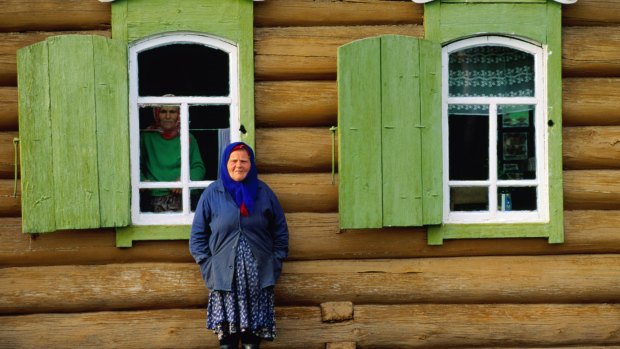
A Woman stands in front of a house in Novosibirsk, Russia.Credit: Peter Solness
And then, back on board the train. Meals on here are gourmet affairs, so much different to my past experience on board the local Trans-Mongolian train, when the restaurant car served up what they called "beef stroganoff" five nights in a row and still managed to give us five completely different meals. On the Csar's Gold that's not the case. Breakfasts are a buffet, lunches are sumptuous four-course feasts of local cuisine, and dinners are slightly lighter three-course spreads.
Tonight, somewhat hilariously, we're being served beef stroganoff, although this version has clearly been prepared by a chef who knows and cares exactly what the dish is supposed to be. It's excellent, and it prepares us well for the next day, when we get to experience one of Russia's great sights: Lake Baikal.
It's the largest freshwater lake in the world, by volume, but that's not the real highlight. The track that hugs the side of this huge waterway was once part of the Trans-Siberian railway, but it has since been bypassed by all but a few local trains, and the Czar's Gold. This section was the most expensive to produce, a spectacular, winding series of tunnels and bridges following the lakeshore.
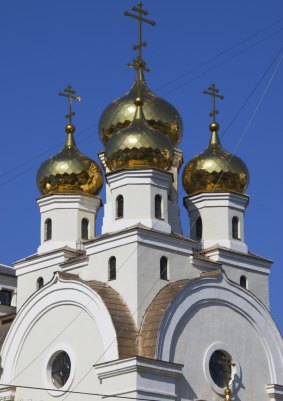
Golden domes of small Orthodox Church (next to Church of the Blood) at the Romanov Death Site, Russia.Credit: Martin Moos
It's so quiet out here, in fact, that our train can afford to stop in a secluded, picturesque spot and allow everyone to jump off and participate in a Russian tradition: a swim in the freezing cold lake. "It will add seven years to your life," says our guide Svetlana, who is conspicuous in her decision not to join us.
Still, there are plenty who take the plunge, and who then warm up with a few shots of vodka while the train's chefs prepare a lakeside barbecue of skewered meats and vegetables, made all the more authentic by the Siberian surrounds.
But the show must go on. After a day spent in Irkutsk – and a night spent in a proper hotel bed – we roll on once more to the west, with a colossal 1800 kilometres of Siberian countryside separating us from our next stop, in Novosibirsk.
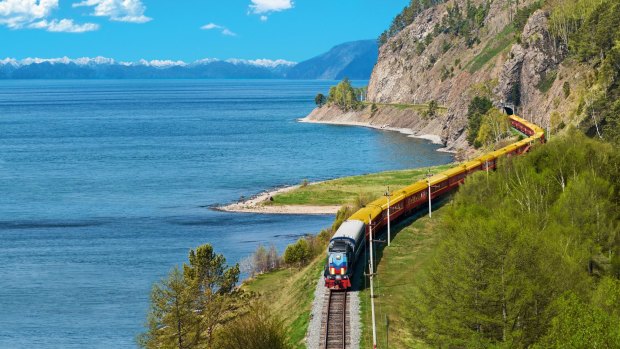
Sonderzugreise "Zarengold".Credit: Roland E. Jung
This is when the rhythm of train life truly takes hold, when you come to appreciate the joy of having nothing to do but stare out the window, of having no sounds around you but the click-clack of wheels on track. There's a day and two nights to spend on board – ample time to appreciate the small things, the way your couch magically becomes a bed while you're eating dinner in the restaurant car, and the way it magically returns to couch form when you stumble off for breakfast the next morning. You have time to listen as Hans, the tour director, gives lectures on Russian culture and history over the train's PA system. You have time to watch as Siberia rattles on by.
GO WEST
"In Siberia," Svetlana says, "we spend nine months of the year in anticipation, and three months in disappointment."
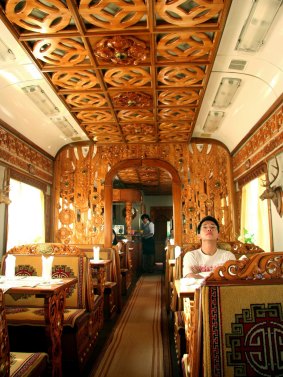
The dining car of the Trans-Mongolian Railway.Credit: John S Lander/Getty Images
This is wry Russian humour at its best, an acknowledgment that this area of the world isn't always the easiest to live in. The winters are long and cold. The summers are short and… cold. But there's life out here, in cities such as Novosibirsk, with its bustling local markets, and Yekaterinburg, with its pedestrian malls and gold-domed churches.
It's an important point on the journey, Yekaterinburg. Not only is it a new city, but a new continent. Asia ends here; Europe begins. And the world changes. Kids are wearing designer jeans. There's a McDonald's. Cafes do takeaway lattes.
Our next stop is Kazan, a resource-rich city that forms part of another semi-autonomous republic, Tatarstan. Lenin and Tolstoy both studied in Kazan. It's a place of wealth and high culture, where we go to the local conservatory of music to see children as young as 12 perform flawless renditions of Tchaikovsky, Bach and Rachmaninoff. They're brilliant.
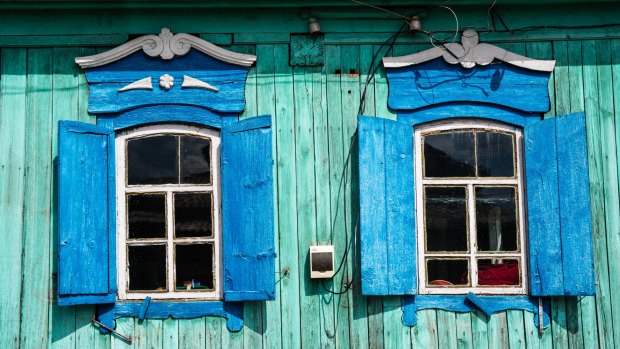
Blue window shutters in Ulan Ude, Siberia, Russia.Credit: Annapurna Mellor
We see Kazan's Kremlin, or castle complex, which houses two buildings that for Tatars are indicative of the harmony of their land: a centuries-old cathedral, its onion domes reaching for the sky, and a newer, more modern mosque, with turquoise minarets making a similarly bold outline.
And then it's time for the final section of our journey, an overnight ride of about 800 kilometres that takes us through the countryside and on into the majestic and slightly intimidating sprawl of our ultimate destination: Moscow. It gets bigger and bigger, denser and denser, as we crawl into the true heart of this enormous and fascinating country.
The bustle of Moscow couldn't be a more different scene to that lonely hilltop in Mongolia so long ago, that cairn of stones crowned by coloured prayer flags, the snapping of the wind, the feeling of anticipation. I'd wished back then for luck, for a safe journey, for a true adventure. And it was granted.
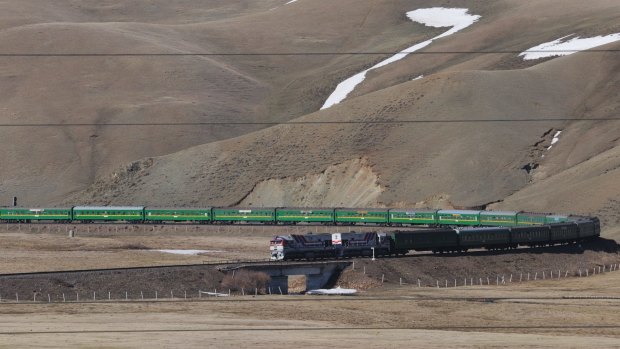
Mongolia, Ulan Baator, Trans-Mongolian express train.Credit: WIN-Initiative
The writer travelled as a guest of Beyond Travel.
TRIP NOTES
MORE INFORMATION
GETTING THERE
Air China flies daily from the east coast of Australia to Beijing, with connecting flights to Ulan Baator and Moscow. See www.airchina.com.au.
TOURING THERE
Beyond Travel has 15-day, 14-night tours aboard the Czar's Gold, departing from Moscow or Beijing, and calling at Ulan Baator, Ulan Ude, Lake Baikal, Irkutsk, Novosibirsk, Yekaterinburg and Kazan. Prices start from $11,625 a person, twin share, including accommodation, all meals on board and selected local meals, service of a tour director and local guides, arrival and departure transfers and local excursions. See website above.
FIVE MUST-SEES ALONG THE WAY
TERELJ NATIONAL PARK, MONGOLIA
It can feel like a little slice of Switzerland has been plonked into the middle of Mongolia at this beautiful national park, with its soaring granite cliffs, green hillsides and forests of birch trees. The Czar's Gold excursion here includes lunch in a traditional ger camp, and a demonstration of Mongolian sports.
LAKE BAIKAL, RUSSIA
The world's largest freshwater lake by volume is also one of the world's most beautiful, a shimmering expanse of blue that's surrounded on all sides by cedar and aspen forests. One of the best nights of the trip is spent having a barbecue on the shores of Lake Baikal, with vodka to warm cold souls.
IRKUTSK DACHA, RUSSIA
A dacha is a traditional Russian holiday home, a modest building that's usually set in a forest outside of the main cities. One of the Czar's Gold excursions is lunch at one of these dachas just near Irkutsk, where a traditional meal of borscht and meatballs is served up in quaint surrounds.
KAZAN KREMLIN, RUSSIA
It's not as well known as its equivalent in Moscow; however, the Kazan Kremlin has plenty going for it, including the 16th-century Annunciation Cathedral, the modern Qolsarif mosque, and the Soyembika Tower, a leaning edifice that dates back to the 1500s. The citadel also commands an excellent view of Kazan city.
MOSCOW KREMLIN, RUSSIA
The famous Moscow citadel is worthy of a full day's exploration, from the armory, containing a dazzling array of jewels and ancient weapons and armour, to the three 15th-century cathedrals at Cathedral Square, to the Ivan the Great Bell Tower, completed in 1600.
FIVE MORE EPIC TRAIN JOURNEYS
MANDOVI EXPRESS, INDIA
There's no better place to experience train travel than India, with its amazing rail network utilised by more than 18 million people every day. An Indian train is a world within a world – there's never a dull moment to be had. One of the best journeys is the 12-hour ride from Madgaon in Goa to Mumbai. See www.indianrail.gov.in
THE GHAN, AUSTRALIA
Though it's a toss-up to name Australia's greatest train journey – the Indian Pacific is definitely up there – the Ghan is still an amazing experience, a four-day journey through the heart of Australia's outback from Adelaide to Darwin. Stops in Coober Pedy, Alice Springs and Katherine make the journey. See www.greatsouthernrail.com.au
BERGEN RAILWAY, NORWAY
There might not be a more scenic train ride in the world, and the most amazing thing of all is that this seven-hour trip from Olso to Bergen is done on a regular old commuter train. It's what's out the window that counts: green valleys, high, snowy plateaus, lakes and mountain streams. Stunning. See www.nsb.no
EASTERN & ORIENTAL EXPRESS, SOUTH-EAST ASIA
This luxurious train makes its way through plenty of south-east Asia's highlights, from Singapore in the south, through Kuala Lumpur, the Cameron Highlands and Bangkok. Onboard, passengers dine on five-star local cuisine, sleep in luxurious cabins, and have the use of a 24-hour butler service. See www.belmond.com
THE CANADIAN, CANADA
The Rocky Mountaineer is without doubt a spectacular journey, but why not extend the enjoyment with the Canadian, a more basic train experience that crosses almost the entire continent of North America, from Vancouver to Toronto. You'll get those Rocky Mountain highs, as well as plenty of prairie lows, and everything in between. See www.viarail.ca
Sign up for the Traveller Deals newsletter
Get exclusive travel deals delivered straight to your inbox. Sign up now.